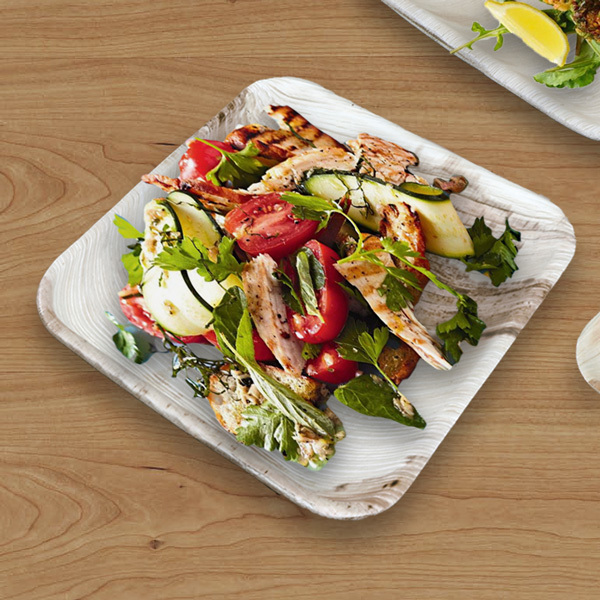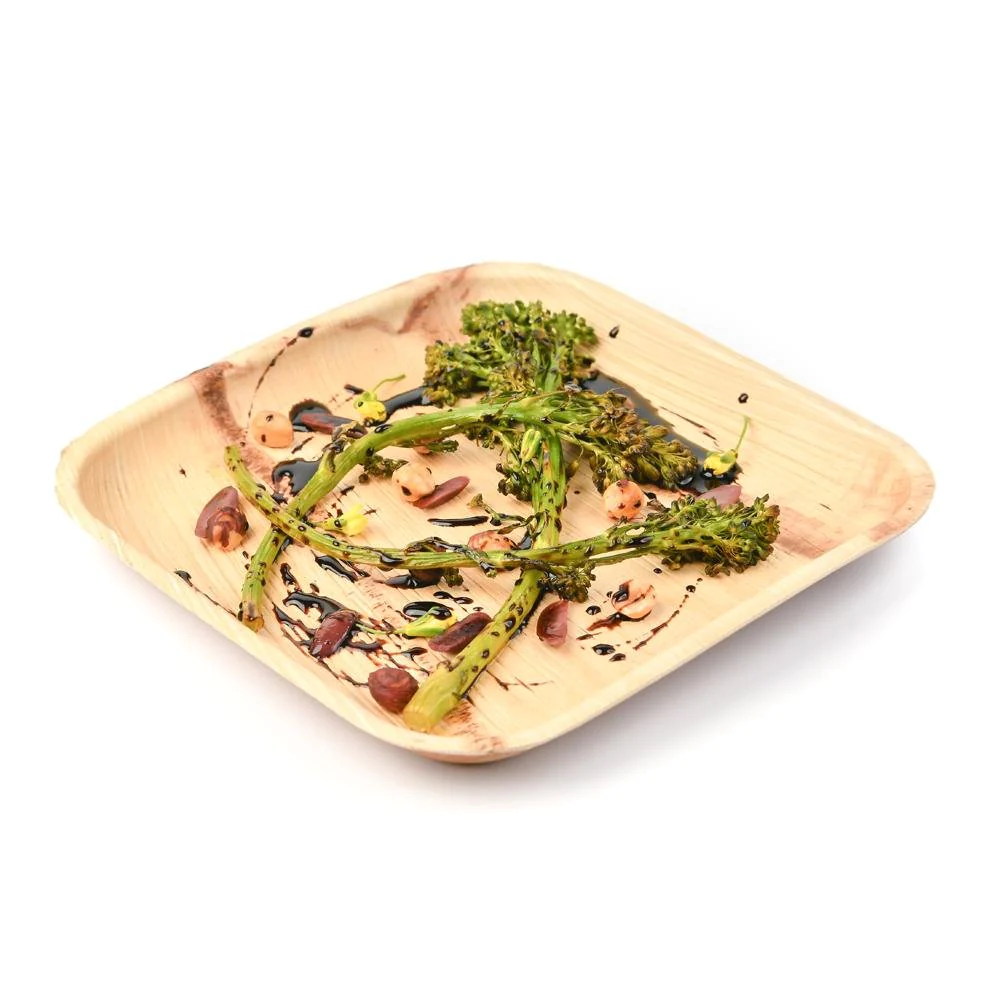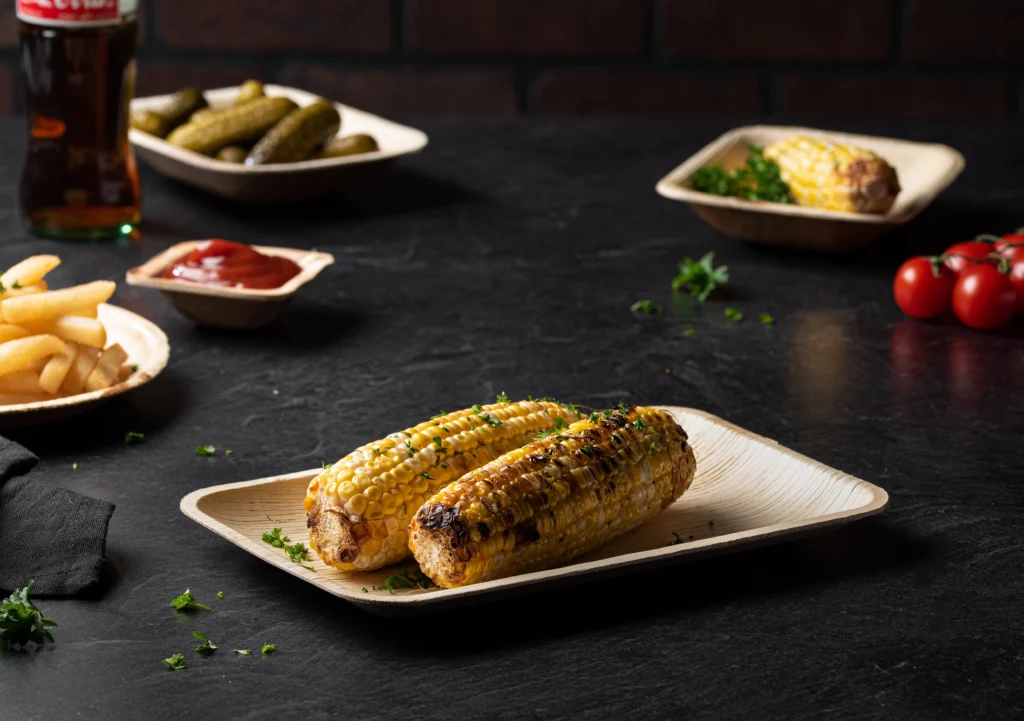Discover the eco-friendly elegance of Palm Leaf Plates for your next event. Learn why choosing these sustainable, biodegradable tableware options is not only better for the environment but adds a unique charm to any table setting. Perfect for weddings, parties, and outdoor gatherings.
Introduction to Sustainable Tableware
In today’s environmentally conscious world, the shift towards sustainable living is more than just a trend—it’s a necessity. As we become more aware of the impact our choices have on the planet, the call for eco-friendly alternatives in every aspect of our lives grows louder. One such area where we can make a significant difference is in our choice of tableware, especially for events and gatherings.
Table of Contents
The Problem with Traditional Disposable Tableware
Environmental Pollution
Traditional disposable tableware, often made from plastics or other non-biodegradable materials, contributes significantly to environmental pollution. When disposed of, these items can take hundreds to thousands of years to break down, accumulating in landfills and natural habitats. They contribute to the growing problem of plastic pollution, which affects soil quality, waterways, and marine life. The visual blight of littered disposable tableware is a common sight in natural landscapes, urban areas, and particularly in the oceans, where plastic waste has created vast garbage patches that harm marine ecosystems.
Resource Depletion
The production of disposable tableware typically involves the consumption of finite resources, such as petroleum for plastic tableware or wood pulp for paper products. The extraction and processing of these resources contribute to deforestation, habitat destruction, and the depletion of natural resources. Additionally, the energy-intensive manufacturing processes of disposable tableware contribute to greenhouse gas emissions, exacerbating climate change.
Chemical Contamination
Many traditional disposable tableware items are made using chemicals that can leach into food and drinks, especially when exposed to heat. Chemicals such as bisphenol-A (BPA), phthalates, and other additives associated with plastics have raised health concerns, including hormonal disruption and increased risk of certain diseases. The use of these materials in food service not only poses a direct risk to consumer health but also contributes to broader environmental contamination as these chemicals can leach into soil and waterways during the decomposition process.
Waste Management Challenges
The sheer volume of disposable tableware consumed globally presents significant waste management challenges. Many of these items are not recycled due to contamination with food waste, lack of recycling infrastructure, or because they are made from materials that are difficult to recycle. As a result, a large proportion of disposable tableware ends up in landfills, where it occupies valuable space and contributes to the generation of methane, a potent greenhouse gas. Additionally, improper disposal can lead to these items entering natural environments, where they pose hazards to wildlife and ecosystems.
Economic Costs
The lifecycle costs of traditional disposable tableware, from production to disposal, can be high. Local governments and communities bear the financial burden of managing waste, including collection, sorting, and disposal. The environmental damage caused by pollution and resource depletion also has long-term economic implications, affecting industries such as tourism, fishing, and agriculture, which rely on healthy ecosystems.

Why Palm Leaf Plates?
Environmental Impact
Palm leaf plates are crafted from the fallen leaves of the Areca palm tree, a natural byproduct that would otherwise decompose. This process involves no harm to the trees, making it a sustainable resource. Utilizing these fallen leaves significantly reduces waste and promotes a circular economy, aligning with principles of sustainability.
Biodegradability and Compostability
Unlike plastic or styrofoam plates, palm leaf plates are 100% biodegradable and compostable. They break down naturally within a few months in a composting environment, returning to the earth without leaving any harmful residues. This feature significantly reduces their environmental footprint, contributing to the reduction of landfill waste and pollution.
Chemical-Free and Non-Toxic
Palm leaf plates are made without the use of chemicals, plastics, or dyes, making them a healthier option for serving food. They do not leach harmful substances into food, ensuring a safer dining experience. This natural composition is particularly appealing in an era where consumers are increasingly concerned about chemical exposure and its impact on health.
Durability and Versatility
Despite their natural origins, palm leaf plates are remarkably sturdy and can handle a wide variety of foods, including hot, wet, or oily dishes, without getting soggy or breaking. This durability, combined with their elegant and rustic aesthetic, makes them suitable for a wide range of occasions, from casual outdoor gatherings to formal events.
Aesthetic Appeal
Palm leaf plates have a unique, natural look that can elevate the presentation of meals. Their earthy tones and textures add a touch of elegance and authenticity to table settings, making them a popular choice for eco-conscious consumers looking to make a statement about sustainability.
Sustainable Production
The production of palm leaf plates is energy-efficient and sustainable. It involves collecting fallen leaves, which are then cleaned, heat-pressed, and shaped into plates. This process requires minimal energy and water, and no trees are cut down, ensuring a low environmental impact.

Contribution to Rural Economies
The manufacturing of palm leaf plates often supports rural communities where these palm trees are abundant. It provides a source of income for families in these areas, promoting economic development without compromising their natural resources or environment.
The Making of Palm Leaf Plates
Collection of Fallen Leaves
The first step in the production of palm leaf plates involves the collection of fallen Areca palm leaves. These leaves, which are naturally shed by the trees, are gathered from the forest floor, ensuring that the process does not involve deforestation or harm to the natural environment. This sustainable sourcing method is an integral part of why palm leaf plates are considered an eco-friendly option.
Cleaning and Sterilization
Once collected, the leaves undergo a thorough cleaning process. They are washed to remove any dirt and debris. After washing, the leaves are sterilized to ensure they are free from bacteria and other microorganisms. This sterilization process typically involves the use of water and heat, avoiding chemicals to maintain the natural purity of the leaves.
Heat Pressing and Molding
After cleaning and sterilization, the leaves are then subjected to a heat pressing process. During this step, the leaves are placed in a press that applies heat and pressure. This process molds the leaves into the desired shape of the plate while also further sterilizing them. The heat and pressure cause the natural sap within the leaf to act as a binding agent, helping the plate to retain its shape without the need for any additional substances or chemicals.
Trimming and Finishing
Once the leaves have been pressed and molded into plates, they are trimmed to remove any rough edges, resulting in a smooth, clean finish. This step ensures that the plates are safe to handle and have a uniform appearance. Some manufacturers might also perform additional quality checks at this stage to ensure each plate meets specific standards.
Natural Features and Variability
An interesting aspect of palm leaf plates is that each plate is unique. The natural variations in the leaves, such as their grain and color, mean that no two plates are exactly alike. This variability adds to the aesthetic appeal of the plates, making them not only a sustainable choice but also a visually appealing one.
Environmental Benefits
The entire process of making palm leaf plates is designed to be as environmentally friendly as possible. It utilizes a renewable resource (fallen leaves), requires minimal processing, and the final product is completely biodegradable and compostable. Furthermore, because the production process is relatively simple and does not require sophisticated machinery, it has a low carbon footprint compared to the manufacturing of traditional disposable tableware.
Supporting Local Communities
The production of palm leaf plates often takes place in rural areas where Areca palm trees are abundant. This provides a source of income for local communities, supporting sustainable livelihoods and contributing to economic development in these regions.

Benefits of Using Palm Leaf Plates
Environmental Sustainability
Palm leaf plates are made from the fallen leaves of the Areca palm tree, making them a highly sustainable option. Since the production process utilizes leaves that would otherwise decompose, it promotes a circular economy approach. These plates are completely biodegradable and compostable, breaking down naturally without contributing to landfill waste or pollution. This starkly contrasts with the environmental impact of traditional disposable tableware, especially plastics, which can take hundreds of years to decompose and are a major source of pollution.
Chemical-Free and Non-Toxic
One of the significant advantages of palm leaf plates is their chemical-free composition. They are produced without the use of synthetic chemicals, binders, or dyes, making them safe for both consumers and the environment. This natural production process ensures that no harmful substances leach into food, a concern often associated with plastic tableware, especially under heat. For individuals and families looking to minimize their exposure to toxins, palm leaf plates offer a safe, natural alternative.
Aesthetic Appeal
Palm leaf plates have a unique, rustic look that adds an element of elegance and authenticity to any dining setting. Their natural patterns, textures, and colors can complement a wide range of decor styles, from casual outdoor picnics to formal dining events. This aesthetic appeal makes palm leaf plates a popular choice for weddings, corporate events, and other occasions where presentation matters as much as sustainability.
Durability and Versatility
Despite their natural origin, palm leaf plates are surprisingly sturdy and versatile. They can handle a wide variety of foods, including hot, wet, or oily dishes, without getting soggy or falling apart. This durability makes them suitable for a broad range of culinary needs, from appetizers and main courses to desserts. Furthermore, their resistance to heat and moisture ensures they can be used in various settings, from outdoor barbecues to elegant dinner parties.
Supports Local Economies
The production of palm leaf plates often provides vital economic opportunities for rural communities in areas where Areca palm trees grow. By sourcing fallen leaves, these communities can generate income without resorting to deforestation or other environmentally harmful practices. This not only helps preserve the natural ecosystem but also supports sustainable livelihoods for local families.
Reduces Dependency on Plastics
By choosing palm leaf plates over plastic alternatives, consumers can significantly reduce their plastic use and contribute to a reduction in plastic waste. This shift away from single-use plastics is crucial in combating plastic pollution, protecting marine life, and reducing the overall environmental footprint associated with disposable tableware.
Easy Disposal and Composting
After use, palm leaf plates can be easily disposed of in a compost bin, where they will naturally decompose, enriching the soil. This ease of disposal not only simplifies clean-up after events but also contributes to the reduction of waste and supports composting efforts, further enhancing their environmental benefits.

Palm Leaf Plates vs. Other Sustainable Options
Palm Leaf Plates vs. Bamboo Tableware
Bamboo Tableware:
- Bamboo is another renewable resource, celebrated for its rapid growth and sustainability. Bamboo tableware is durable, reusable, and biodegradable under the right conditions.
- However, the production of bamboo tableware often involves more intensive processing, including the use of chemicals and binders to shape and finish the products.
Palm Leaf Plates:
- Palm leaf plates, on the other hand, are made from naturally fallen leaves, requiring minimal processing with no chemicals or binders. This results in a lower environmental impact during production.
- Each palm leaf plate is unique, featuring the natural grain and texture of the leaf, whereas bamboo products are more uniform in appearance.
Palm Leaf Plates vs. Paper Tableware
Paper Tableware:
- Paper products are widely used as a disposable and biodegradable option. They are made from a renewable resource but often involve deforestation unless made from recycled materials.
- Many paper tableware options are coated with plastic or wax to prevent leaks, which can complicate recycling and composting, reducing their environmental benefit.
Palm Leaf Plates:
- Palm leaf plates offer superior durability compared to paper tableware, capable of handling wet and oily foods without leaking or becoming soggy.
- They are completely compostable and biodegradable without any coatings, making them a more environmentally friendly option.
Palm Leaf Plates vs. Reusable Tableware
Reusable Tableware:
- Reusable tableware, made from materials like glass, ceramic, or metal, is arguably the most sustainable option in terms of waste reduction, as it can be used for years.
- The environmental impact of reusable tableware largely depends on the resources used in production and the energy consumed during washing after each use.
Palm Leaf Plates:
- While not reusable, palm leaf plates are an excellent single-use option for events where reusable tableware is impractical due to logistics or lack of facilities for washing.
- They offer a balance between convenience and sustainability, providing an eco-friendly alternative without the need for water and energy consumption associated with cleaning reusable tableware.

How to Incorporate Palm Leaf Plates in Your Events
Choose the Right Event
Palm leaf plates are versatile and suitable for a wide range of events, including:
- Weddings: Their natural elegance makes them perfect for eco-friendly weddings.
- Corporate Events: Impress guests with your company’s commitment to sustainability.
- Outdoor Gatherings: Ideal for picnics, barbecues, and garden parties where disposability adds convenience without compromising on environmental ethics.
- Holiday Celebrations: Add a unique touch to holiday feasts and celebrations.
- Catered Events: Offer a point of difference with sustainable tableware options.
Consider the Theme and Decor
Palm leaf plates naturally complement themes that emphasize nature, rustic elegance, or bohemian styles. However, their neutral color and unique texture also make them versatile enough to fit into more formal settings. Consider pairing them with:
- Natural Table Decor: Use linen tablecloths, burlap runners, and centerpieces featuring wildflowers, succulents, or branches.
- Eco-friendly Tableware: Complement palm leaf plates with other sustainable tableware, like bamboo cutlery and glass or metal drinkware.
- Decorative Accents: Enhance the plates’ natural beauty with decorative elements that match the event’s color scheme or theme.
Plan Your Menu Accordingly
The robust nature of palm leaf plates makes them suitable for a wide variety of foods, from hot main courses to cold appetizers and desserts. However, their unique texture and shape can add an extra dimension to your presentation:
- Showcase Colorful Foods: Bright, vibrant dishes can look particularly striking against the earthy backdrop of a palm leaf plate.
- Consider Portion Sizes: Choose dishes that fit well on the plates, ensuring they’re not overcrowded or underutilized.
- Use Them for All Courses: Don’t hesitate to use palm leaf plates for everything from starters through to desserts to maintain a consistent aesthetic throughout the meal.
Communicate the Choice to Guests
Part of incorporating palm leaf plates into your event involves educating your guests about the sustainable choices you’re making:
- Explain the Benefits: Use signage or mention in speeches or programs why you chose palm leaf plates, focusing on their environmental advantages and unique qualities.
- Encourage Proper Disposal: If appropriate, provide information on how guests can dispose of the plates responsibly, whether that’s through composting bins at the event or taking them home for personal composting efforts.
Pair with Other Sustainable Practices
To further enhance the sustainability of your event:
- Minimize Waste: Encourage minimal waste by planning portions carefully and providing recycling and composting options.
- Choose Seasonal and Local: Opt for menu items that are seasonal and locally sourced to reduce the carbon footprint associated with food transportation.
- Eco-friendly Favors: Consider giving guests eco-friendly favors, such as seed packets or reusable items, that align with the event’s sustainability theme.

Challenges and Considerations
Cost
One of the primary considerations when opting for palm leaf plates is their cost. Compared to conventional plastic or paper disposables, palm leaf plates can be more expensive. This price difference is due to the sustainable production methods and the manual labor involved in their creation. For large events or regular use, the cost can add up, making it essential to budget accordingly or consider them for special occasions rather than everyday use.
Availability
Depending on your location, palm leaf plates might not be as readily available as other types of disposable tableware. While they are becoming increasingly popular and can be found online and in some specialty stores, they might not be as accessible in all areas. This potential lack of availability can require more planning and possibly dealing with shipping times and costs.
Disposal and Composting
Although palm leaf plates are biodegradable and compostable, the effectiveness of these processes depends on the conditions in which they are disposed of. Not all regions have accessible commercial composting facilities, and home composting systems may not be suitable for everyone. Additionally, for the plates to decompose efficiently, they need to be processed in a properly managed composting environment, which may not be available to all users.
Guest Perception
While many guests will appreciate the sustainability and unique aesthetic of palm leaf plates, others may have different expectations, especially at formal events. Some people may perceive them as less elegant or too casual compared to traditional china or glassware. Educating your guests about the environmental benefits and the rationale behind choosing palm leaf plates can help mitigate any potential concerns.
Consistency and Quality
Due to their natural origin, palm leaf plates can vary in size, shape, and color. While many find this variability charming and a testament to their eco-friendly nature, it can be a challenge for those seeking a uniform look for their event. It’s essential to source the plates from reputable suppliers to ensure consistent quality and to order extra to accommodate any variability.
Environmental Impact of Production and Shipping
While palm leaf plates are sustainable, it’s important to consider the environmental impact of their production and shipping, especially if they are being transported long distances. Opting for suppliers that prioritize sustainable practices and minimize carbon footprints can help mitigate this concern.
Legal and Health Regulations
In some regions, there may be legal and health regulations regarding the use of disposable tableware for serving food, particularly in commercial settings. It’s crucial to ensure that palm leaf plates meet these requirements and are safe for food contact according to local laws and guidelines.
Conclusion
Choosing palm leaf plates for your table is a step towards sustainability that doesn’t compromise on style or functionality. Their environmental benefits, coupled with their unique aesthetic, make them an excellent choice for anyone looking to reduce their ecological footprint while hosting an event.
FAQs
- Are palm leaf plates reusable?
- How long does it take for palm leaf plates to compost?
- Can palm leaf plates handle liquid foods?
- Where can I buy palm leaf plates?
- Are palm leaf plates more expensive than traditional disposable plates?
